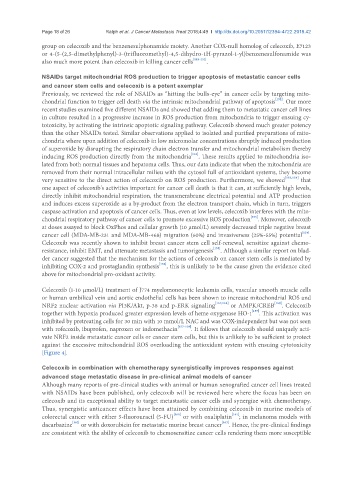Page 598 - Read Online
P. 598
Page 18 of 26 Ralph et al. J Cancer Metastasis Treat 2018;4:49 I http://dx.doi.org/10.20517/2394-4722.2018.42
group on celecoxib and the benzenesulphonamide moiety. Another COX-null homolog of celecoxib, E7123
or 4-(5-(2,5-dimethylphenyl)-3-(trifluoromethyl)-4,5-dihydro-1H-pyrazol-1-yl)benzenesulfonamide was
also much more potent than celecoxib in killing cancer cells [149-151] .
NSAIDs target mitochondrial ROS production to trigger apoptosis of metastatic cancer cells
and cancer stem cells and celecoxib is a potent exemplar
Previously, we reviewed the role of NSAIDs as “hitting the bulls-eye” in cancer cells by targeting mito-
[152]
chondrial function to trigger cell death via the intrinsic mitochondrial pathway of apoptosis . Our more
recent studies examined five different NSAIDs and showed that adding them to metastatic cancer cell lines
in culture resulted in a progressive increase in ROS production from mitochondria to trigger ensuing cy-
totoxicity, by activating the intrinsic apoptotic signaling pathway. Celecoxib showed much greater potency
than the other NSAIDs tested. Similar observations applied to isolated and purified preparations of mito-
chondria where upon addition of celecoxib in low micromolar concentrations abruptly induced production
of superoxide by disrupting the respiratory chain electron transfer and mitochondrial metabolism thereby
[153]
inducing ROS production directly from the mitochondria . These results applied to mitochondria iso-
lated from both normal tissues and hepatoma cells. Thus, our data indicate that when the mitochondria are
removed from their normal intracellular milieu with the cytosol full of antioxidant systems, they become
very sensitive to the direct action of celecoxib on ROS production. Furthermore, we showed [153,154] that
one aspect of celecoxib’s activities important for cancer cell death is that it can, at sufficiently high levels,
directly inhibit mitochondrial respiration, the transmembrane electrical potential and ATP production
and induces excess superoxide as a by-product from the electron transport chain, which in turn, triggers
caspase activation and apoptosis of cancer cells. Thus, even at low levels, celecoxib interferes with the mito-
[153]
chondrial respiratory pathway of cancer cells to promote excessive ROS production . Moreover, celecoxib
at doses assayed to block OxPhos and cellular growth (10 μmol/L) severely decreased triple negative breast
[154]
cancer cell (MDA-MB-231 and MDA-MB-468) migration (60%) and invasiveness (25%-55%) potential .
Celecoxib was recently shown to inhibit breast cancer stem cell self-renewal, sensitize against chemo-
[155]
resistance, inhibit EMT, and attenuate metastasis and tumorigenesis . Although a similar report on blad-
der cancer suggested that the mechanism for the actions of celecoxib on cancer stem cells is mediated by
[156]
inhibiting COX-2 and prostaglandin synthesis , this is unlikely to be the cause given the evidence cited
above for mitochondrial pro-oxidant activity.
Celecoxib (1-10 μmol/L) treatment of J774 myelomonocytic leukemia cells, vascular smooth muscle cells
or human umbilical vein and aortic endothelial cells has been shown to increase mitochondrial ROS and
NRF2 nuclear activation via PI3K/Akt, p-38 and p-ERK signaling [157,158] or AMPK/CREB [159] . Celecoxib
[157]
together with hypoxia produced greater expression levels of heme oxygenase HO-1 . This activation was
inhibited by pretreating cells for 30 min with 10 mmol/L NAC and was COX-independent but was not seen
with rofecoxib, ibuprofen, naproxen or indomethacin [157-159] . It follows that celecoxib should uniquely acti-
vate NRF2 inside metastatic cancer cells or cancer stem cells, but this is unlikely to be sufficient to protect
against the excessive mitochondrial ROS overloading the antioxidant system with ensuing cytotoxicity
[Figure 4].
Celecoxib in combination with chemotherapy synergistically improves responses against
advanced stage metastatic disease in pre-clinical animal models of cancer
Although many reports of pre-clinical studies with animal or human xenografted cancer cell lines treated
with NSAIDs have been published, only celecoxib will be reviewed here where the focus has been on
celecoxib and its exceptional ability to target metastastic cancer cells and synergize with chemotherapy.
Thus, synergistic anticancer effects have been attained by combining celecoxib in murine models of
[161]
colorectal cancer with either 5-fluorouracil (5-FU) [160] or with oxaliplatin ; in melanoma models with
[162]
[163]
dacarbazine or with doxorubicin for metastatic murine breast cancer . Hence, the pre-clinical findings
are consistent with the ability of celecoxib to chemosensitize cancer cells rendering them more susceptible

